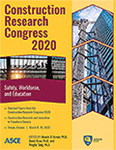Construction Research Congress 2020
Advancing Best Practices for Safety in Residential Construction
Publication: Construction Research Congress 2020: Safety, Workforce, and Education
ABSTRACT
Safety is paramount to the success of any construction company. Strides have been made to improve safety performance throughout the industry. However, smaller residential construction firms still have a higher accident and injury rate than other sectors of the industry. This research is looking at the development of best practices for smaller firms working mainly in the residential construction industry. A comparative analysis of safety cultures between top performing firms and those with a poorer safety performance is conducted. The findings highlight the key drivers of safety programs for high performing firms that are not implemented in those with poorer safety performance. The research methodology included an initial screening survey with follow up interviews to drill down on key performance indicators. The results are presented in the development of best practices that smaller firms can implement. This paper discusses the methodology used to collect the data and the key performance indicators that were identified as a result of the first phase of the study.
Get full access to this article
View all available purchase options and get full access to this chapter.
ACKNOWLEDGEMENTS
This project is being funded in part by the Jobsite Safety Institute (JSI). All views in this paper are those of the authors and do not necessarily represent those of JSI.
REFERENCES
Anderson, L. P. Nordam, L. Joensson, T. Kines, P & Nielsen, K. J. (2018). “Social identity, safety climate and self-reported accidents among construction workers.” Construction Management and Economics. 36(1), 22-31.
Amiri, M. & Ardeshir, A. (2017). “Fuzzy probabilistic expert system for occupational hazard assessment in construction.” Safety Science, 93, 16-28.
Bigelow, P., Chen, P., Keefe, T., Del Puerto, C. L., Rosecrance, J., Herron, R., & Gilkey, D. P. (2012). “Comparative analysis of safety culture perceptions among Home Safe managers and workers in residential construction.” J. Const. Eng. Mgmt., 138(9), 1044-1052.
Cheng, E. W. L., Kelly, S., & Ryan, N. (2015). “Use of safety management practices for improving project performance.” Int. J. Injury Control and Safety Promotion, 22(1), 33-39.
Cheng, E. W. L., Ryan, N., & Kelly, S. (2012). “Exploring the perceived influence of safety management practices on project performance in the construction industry.” Safety Science, 50(2), 363-369.
Choudhry, R. M., Fang, D., & Ahmed, S. M. (2008). “Safety management in construction: Best practices in Hong Kong.” J. Prof. Issues Eng. Education and Practice, 134(1), 20-32.
Esmaeili, B., & Hallowell, M. R. (2012). “Diffusion of safety innovations in the construction industry.” J. Const. Eng. Mgmt., 138(8), 955-963.
Findley, M., Smith, S., Kress, T., Petty, G., and Enoch, K. (2004). “Safety Program Elements in Construction.” Journal of Professional Safety, 49(2), 14-21.
Gagne, R. (2011). What Does a Workplace Injury Cost? Direct Versus Indirect Costs and Their Affect to the Bottom Line, Fit2WRK, retrieved on July 26, 2019 <http://www.dorncompanies.com/downloads/articles/cost_of_a_work_place_injury.pdf
Gambatese, J., & Hinze, J. (2003). “Factors that influence safety performance of specialty contractors.” J. Const. Eng. Mgmt., 129(2), 159-164.
Guo, B. H. W., & Yiu, T. W. (2016). “Developing leading indicators to monitor the safety conditions of construction projects.” J. Const. Eng. Mgmt., 32(1), 4015016.
Hallowell, M. (2010). “Cost-effectiveness of construction safety programme elements.” Construction Management and Economics, 28(1), pp.25-34.
Hallowell, M. R. (2011). “Risk-based framework for safety investment in construction organizations.” J. Const. Eng. Mgmt., 137(8), 592-599.
Hallowell, M. R., & Calhoun, M. E. (2011). “Interrelationships among highly effective construction injury prevention strategies.” J. Const. Eng. Mgmt., 137(11), 985-993.
Hallowell, M. R., & Gambatese, J. A. (2009). “Construction safety risk mitigation.” J. Const. Eng. Mgmt., 135(12), 1316-1323.
Hinze, J. (2002). Safety incentives: Do they reduce injuries? Practice Periodical on Structural Design and Construction, 7(2), 81-84.
Hinze, J., Baud, K., & Hallowell, M. (2013). “Construction-safety best practices and relationships to safety performance.” J. Const. Eng. Mgmt., 139(10), 4013006.
Jazayeri, E. & Dadi, G. B. (2017). “Construction Safety Management Systems and methods of safety performance measurement: A Review,” J. Safety Engineering. 6, (2)15-28.
Karakhan, A. A., Rajendran, S., Gambatese, J., & Nnaji, C. (2018). “Measuring and evaluating safety maturity of construction contractors: Multicriteria decision-making approach.” J. Const. Eng. Mgmt., 144(7), 4018054.
Mohammadi, A., Tavakolan, M., & Khosravi, Y. (2018). “Factors influencing safety performance on construction projects: A review.” Safety Science, 109, 382-397.
Marin, L. S. & Roelofs, C. (2018). “Engaging Small residential Construction Contractors in Community-Based Participatory Research to Promote Safety.” Annals of Work Exposures and Health, 62(1), 572-580.
Meeds, L. (1974). “Legislative History of OSHA.” Gonzaga Law Review, 9(2), 327-348.
Ringen, K. Dong, X. S. Goldenhar, L. M. & Cain, C. T. (2018). “Construction Safety and Health in the USA: Lessons from a Decade of Turmoil.” Annals of Work Exposures and Health 62(1), 525-533.
Russell, J.S., Anderson, S.D., & Jaselskis, E.J. (1996). Strategies for achieving excellence in construction safety performance. J. Const. Eng. Mgmt., 122(1), 61-70.
Sparer, E. H., Herrick, R. F., & Dennerlein, J. T. (2015). “Development of a safety communication and recognition program for construction.” NEW SOLUTIONS: A Journal of Environmental and Occupational Health Policy, 25(1), 42-58.
Swacha, E., Naoum, S., & Fong, D. (1999). “Factors affecting safety performance on construction sites.” International Journal of Project Management, 7(5), 309-315.
Wehle, A., Hinze, J. W., Baud, K. C., & Hallowell, M. R. (2013). “Proactive construction safety control: Measuring, monitoring, and responding to safety leading indicators.” J. Const. Eng. Mgmt., 139(10), 4013010.
Information & Authors
Information
Published In
Construction Research Congress 2020: Safety, Workforce, and Education
Pages: 165 - 174
Editors: Mounir El Asmar, Ph.D., Arizona State University, David Grau, Ph.D., Arizona State University, and Pingbo Tang, Ph.D., Arizona State University
ISBN (Online): 978-0-7844-8287-2
Copyright
© 2020 American Society of Civil Engineers.
History
Published online: Nov 9, 2020
Published in print: Nov 9, 2020
Authors
Metrics & Citations
Metrics
Citations
Download citation
If you have the appropriate software installed, you can download article citation data to the citation manager of your choice. Simply select your manager software from the list below and click Download.
